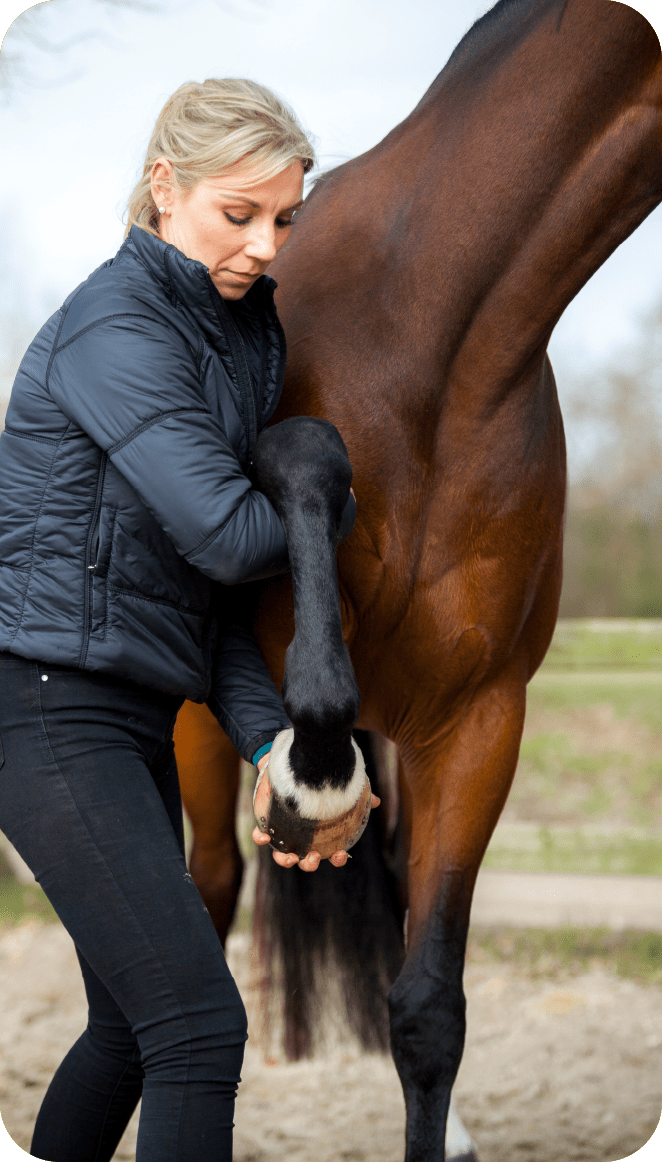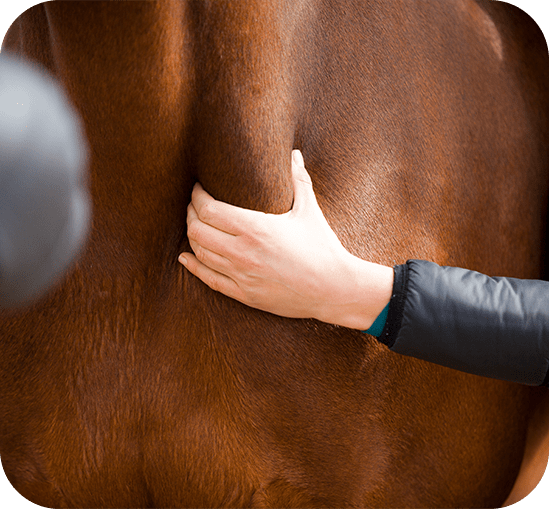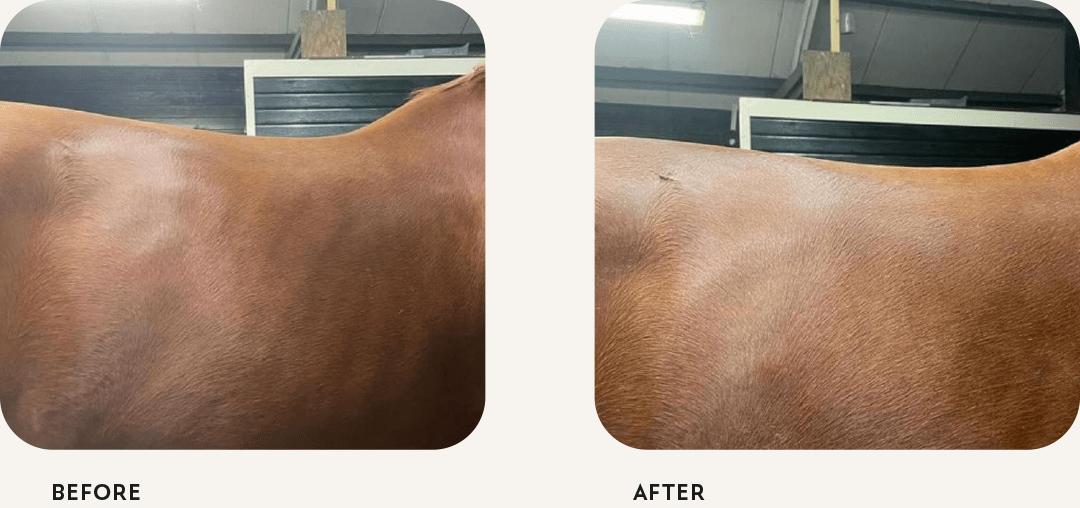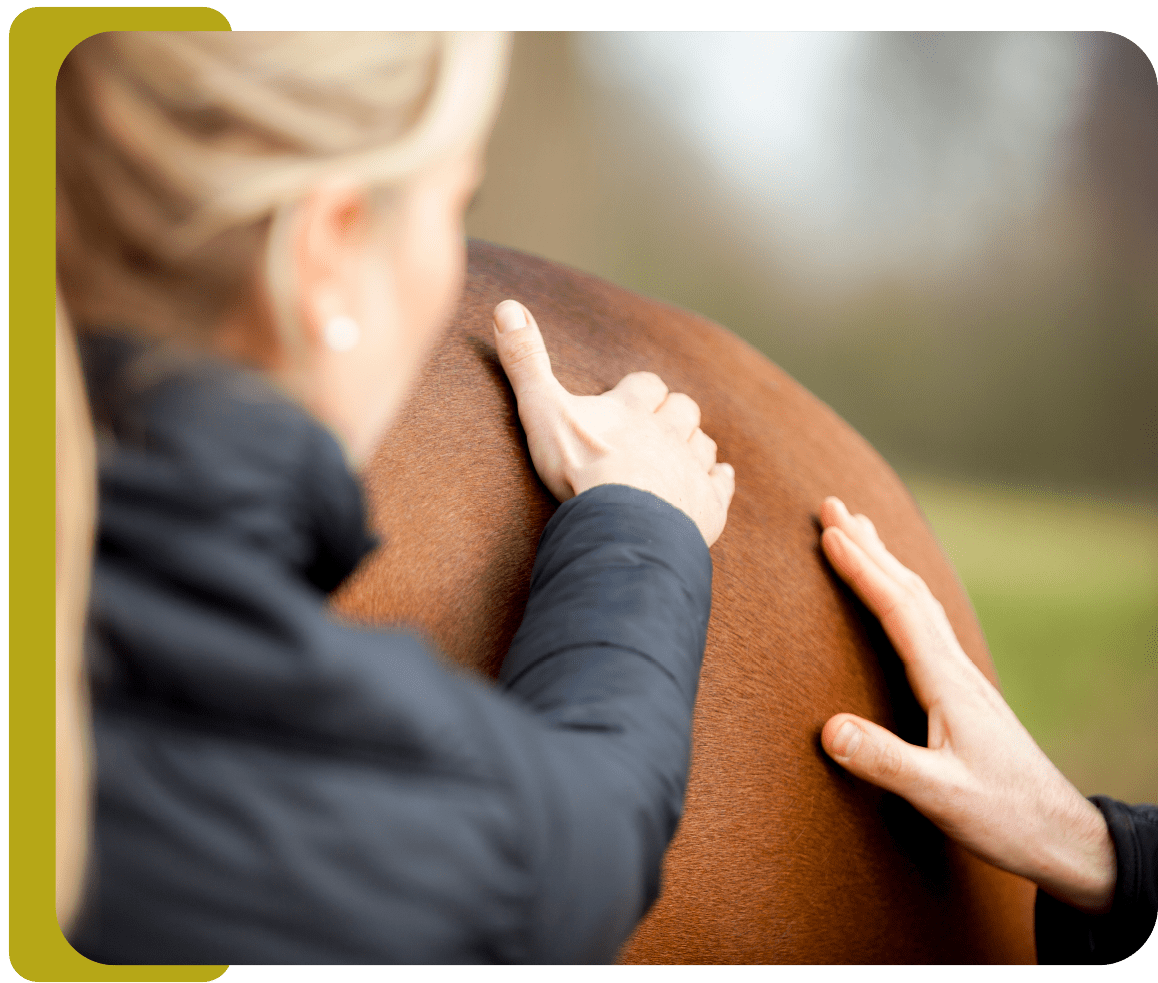Innovation in
treatment methodology
for sport horses
AMNF
therapy
Artro-myofasciale neurofeedback therapie is een nieuwe ontwikkeling in behandelmethodiek, revalidatie en voor het begeleiden van (sport)paarden. Deze richt zich op herstellen van geïrriteerd en beschadigd bindweefsel voornamelijk in weke-delen letsels.
Innovation in
treatment methodology
for sport horses
AMNF therapy
Arthromyofascial neurofeedback therapy is a new development in treatment methods, rehabilitation, and for supporting (sport) horses. It focuses on restoring irritated and damaged connective tissue, primarily in soft-tissue injuries.

Evidence based practice proved therapy
AMNF-therapy is an innovative method that has been developed on the basis of practice based evidence. This means that the findings from the AMNF-therapy research are measured and evaluated treatment. The results are analyzed and validated by a practice based evidence proved software system. The aim is to measure and clarify the effectiveness of the treatment. A related goal is to be able to lower the threshold to collaboration with regular medicine and to improve the quality of the veterinary and para-medical health care.
What is AMNF therapy?
Arthro-myofascial stands for the connection between joints (arthro), muscles (myo) and membrane (fascia). Neurofeedback stands for the direct communication between the nerves (neuro) and the central nervous system. These communicate with each other, e.g. through and external signal, which is transmitted (internally) by the nerves to the central nervous system. The brain processes the information and feeds this information back (feedback) to the place where the signal was delivered. The AMNF-therapy is focussed to solve “chain problems and projections” between these components.
Do you want to see what it can possibly mean for your horse? Follow us on Instagram!
Evidence based practice proved therapy
AMNF-therapy is an innovative method that has been developed on the basis of practice based evidence. This means that the findings from the AMNF-therapy research are measured and evaluated treatment. The results are analyzed and validated by a practice based evidence proved software system. The aim is to measure and clarify the effectiveness of the treatment. A related goal is to be able to lower the threshold to collaboration with regular medicine and to improve the quality of the veterinary and para-medical health care.
What is AMNF therapy?
Arthro-myofascial stands for the connection between joints (arthro), muscles (myo) and membrane (fascia). Neurofeedback stands for the direct communication between the nerves (neuro) and the central nervous system. These communicate with each other, e.g. through and external signal, which is transmitted (internally) by the nerves to the central nervous system. The brain processes the information and feeds this information back (feedback) to the place where the signal was delivered. The AMNF-therapy is focussed to solve “chain problems and projections” between these components.
Do you want to see what it can possibly mean for your horse? Follow us on Instagram!

Casus
KWPN mare, 12 years old, Grand Prix dressage level. Problems with lead changes, pirouette, half-pass, and piaffe.
Photo 1. Before treatment. The image shows a more lordotic (hollow) spinal contour with hypertonicity of the muscles. Muscle contouring due to tension is visible. The pelvis is tilted slightly forward.
Photo 2. Immediately after treatment with AMNF therapy, showing a decrease in lordosis (hollowness), relaxation of the muscles, and reduced contouring. A longer line is visible in the lumbar region, with the pelvis returning to its normal position.
1 AMNF therapy treatment with an immediately visible effect.
Results: free of complaints.


How does a treatment work?
Every case will start with a physiotherapeutic examination, with palpation, function and mobility tests and movement analyses at the longe and under the saddle. In this, the request to help becomes the red line trough the research, which focuses on mapping findings of pain, joints, muscle, capsule, and ligament irritations and tissue damage.
This produces treatable components that are treated with a high power laser class IV and manual neurofeedback techniques and manipulations. The practitioner palpates with the fingers and hands the affected structures, for example a tension (hypertonia) of a muscle and first treats the hypertonic muscle with a high power laser, with reduces the pain and inflammation, stimulates blood flow, reduces swelling and activities cell ATP production for directly cell regeneration. During the treatment, the practitioner applies manual neurofeedback techniques that are also pain-free and pleasantly experience for the horse.
Meanwhile the treatment you can see that the affected structures change and after the treatment, you can visibly observe a change in the horse’s posture. This is followed by the recovery phase from day 1. till day 14. In which the activated cells renew and recover. During this 14 day period, targets training is appleid to the treatable region and appropriate to the treatment plan named, training out of anatomical and biomechanical perspective.
Casus
KWPN mare, 12 years old, Grand Prix dressage level. Problems with lead changes, pirouette, half-pass, and piaffe.
Photo 1. Before treatment. The image shows a more lordotic (hollow) spinal contour with hypertonicity of the muscles. Muscle contouring due to tension is visible. The pelvis is tilted slightly forward.
Photo 2. Immediately after treatment with AMNF therapy, showing a decrease in lordosis (hollowness), relaxation of the muscles, and reduced contouring. A longer line is visible in the lumbar region, with the pelvis returning to its normal position.
1 AMNF therapy treatment with an immediately visible effect.
Results: free of complaints.
How does a treatment work?
Every case will start with a physiotherapeutic examination, with palpation, function and mobility tests and movement analyses at the longe and under the saddle. In this, the request to help becomes the red line through the research, which focuses on mapping findings of pain, joints, muscle, capsule, and ligament irritations and tissue damage.
This produces treatable components that are treated with a high power laser class IV and manual neurofeedback techniques and manipulations. The practitioner palpates with the fingers and hands the affected structures, for example a tension (hypertonia) of a muscle and first treats the hypertonic muscle with a high power laser, with reduces the pain and inflammation, stimulates blood flow, reduces swelling and activities cell ATP production for directly cell regeneration. During the treatment, the practitioner applies manual neurofeedback techniques that are also pain-free and pleasantly experience for the horse.
Meanwhile the treatment you can see that the affected structures change and after the treatment, you can visibly observe a change in the horse’s posture. This is followed by the recovery phase from day 1. till day 14. In which the activated cells renew and recover. During this 14 day period, targets training is applied to the treatable region and appropriate to the treatment plan named, training out of anatomical and biomechanical perspective.

Casus
Before: Clearly visible lameness in de right hind and left front. Rigidity visible in the topline and mental discomfort.
After: Treatment with the Horse Dynamics Method. The rider and trainer Marijn shows beautiful and harmonious riding in a flowing tölt. Physical en mental healthy expression. This great outcome is the result of the consistent and disciplined management and training skills of Marijn.
BEFORE
AFTER
Casus
Before: Clearly visible lameness in de right hind and left front. Rigidity visible in the topline and mental discomfort.
After: Treatment with the Horse Dynamics Method. The rider and trainer Marijn shows beautiful and harmonious riding in a flowing tölt. Physical en mental healthy expression. This great outcome is the result of the consistent and disciplined management and training skills of Marijn.
BEFORE
AFTER
BEFORE
AFTER
Casus
Before: The horse shows lameness and general unwellness.
After: The result of the Horse Dynamics method combined with Lisa’s outstanding training and management. Lisa shows beautiful and harmonious horse riding, the horse is complaint free, loose through the body and has fun moving.
Casus
Before: The horse shows lameness and general unwellness.
After: The result of the Horse Dynamics method combined with Lisa’s outstanding training and management. Lisa shows beautiful and harmonious horse riding, the horse is complaint free, loose through the body and has fun moving.
BEFORE
AFTER
Casus
Before: Right front lameness visible in the loading fase of the stride. The horse tightens the topline and has reduced lateral bending to the right. He doesn’t like to move on the right circle.
After: Direct treatment: shoeing adjustment right front only. You can see that the horse does load the foot again, improves in the stride length, relaxes the topline and wants to go easily on the right circle again.
BEFORE
AFTER
Casus
Before: Right front lameness visible in the loading fase of the stride. The horse tightens the topline and has reduced lateral bending to the right. He doesn’t like to move on the right circle.
After: Direct treatment: shoeing adjustment right front only. You can see that the horse does load the foot again, improves in the stride length, relaxes the topline and wants to go easily on the right circle again.
BEFORE
AFTER






